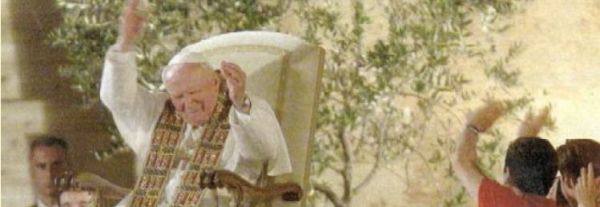1. "Just as the day was breaking, Jesus stood on the beach" (Jn 21: 4). At the crack of dawn, the Risen One appeared to the Apostles, who had just returned after a night of unsuccessful fishing on the lake of Tiberias. The Evangelist explains that on that night "they caught nothing" (Jn 21: 3) and adds that they had nothing to eat. They obeyed Jesus' invitation: "Cast the net on the right side of the boat, and you will find some" (Jn 21: 6) without hesitation. Their response was prompt and their reward great, because all night long their net had been empty and now, "they were not able to haul it in for the great quantity of fish" (Jn 21: 6).
How can we not see in this episode, which St John mentions in the epilogue of his Gospel, an eloquent sign of what the Lord continues to do in the Church and in the hearts of believers who trust in him without reserve? The five Servants of God whom I have had the joy of raising to the honour of the altars today are special witnesses of the extraordinary gift which the risen Christ lavishes upon every baptized person: the gift of holiness.
Blessed are those who make this mysterious gift fruitful, allowing the Holy Spirit to conform their lives to Christ who died and was raised! Blessed are you who shine today like bright stars in the firmament of the Church: Manuel González García, Bishop, Founder of the Congregation of the Misioneras Eucarísticas de Nazaret; Carlos Manuel Cecilio Rodríguez Santiago, layman; Marie Anne Blondin, virgin, foundress of the Congregation of the Sisters of St Anne; Caterina Volpicelli, virgin, foundress of the Servants of the Sacred Heart; Caterina Cittadini, virgin, foundress of the Ursuline Sisters of Somasca.
Each one of you, in promising yourselves to Christ, made the Gospel the your rule of life. Thus you became his faithful disciples, having drawn that newness of life, inaugurated by the mystery of the Resurrection, from the inexhaustible spring of his love.
2. "That disciple whom Jesus loved said to Peter, "It is the Lord' " (Jn 21: 7). In the Gospel we have heard that seeing the miracle worked, a disciple recognizes Jesus. The others will recognize him later. In presenting to us Jesus who "came and took the bread and gave it to them" (Jn 21: 13), the Gospel points out how and when we can meet the risen Christ: in the Eucharist, where Jesus is truly present under the appearances of bread and wine. It would be sad if, after so long, the Saviour's loving presence were still to be unknown by humanity.
This was the great passion of the new blessed, Bl. Manuel González García, Bishop of Malaga and later of Palencia. His experience before a deserted tabernacle in Palomares del Río was to mark his whole life, and from that moment he dedicated himself to spreading devotion to the Eucharist, proclaiming the words he subsequently chose as his epitaph: "Here is Jesus! He is here! Do not abandon him!" Bl. Manuel González, founder of the Misioneras Eucarísticas de Nazaret, is a model of Eucharistic faith whose example continues to speak to the Church today.
3. "None of the disciples dared ask him, "Who are you?'. They knew it was the Lord" (Jn 21: 12). When the disciples recognize him by the lake of Tiberias, their faith in Christ, risen and present among his disciples, is strengthened. For two millennia the Church has not tired of proclaiming and repeating this fundamental truth of faith.
[Pope John Paul II, homily 29 April 2001]












